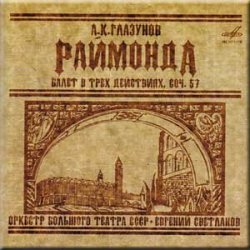Alexander Glazunov – Raymonda Op.57 (1961)
Alexander Glazunov – Raymonda Op.57 (1961)

ACT ONE First Tableau 1. Introduction 2. Scene 1: Pages are exercising aux arms; others are playing the lute and the viols 3. The deceiver. Some girls leave their work and go to dance with the pages 4. Scene 2: Entrance of the ladies of honour 5. Repeat of the dance 6. Mime scene 7. The countess' story 8. Dances 9. Scene 3: Mime scene 10. Scene 4: Entrance of Raymonda 11. Scene 5: Mime scene 12. Scene 6: Entrance of the vassals and peasants 13. Grand waltz 14. "Pizzicato" (Pas de Raymonda) 15. Repeat of the waltz 16. Mime scene 17. Prelude and the Romanesca 18. Prelude and variation 19. Mime scene 20. Scene 7: Appearance of the White Lady 21. Entr'acte Second Tableau play 22. Scene 8: Fantasy scene Third Tableau (Raymonda's dream) 23. Grand Adagio 24. Fantasy waltz 25. Variation I 26. Variation II 27. Variation III 28. Coda 29. Scene 9: Mime scene 30. Scene 10: Round of will-o-the-wisps and elves 31. Scene 11: Day breaks 32. Scene 12: The women and pages appear on the terrace and seeing their mistress lying unconscious ACT TWO 1. Entr'acte 2. Scene 1: March 3. Scene 2: Entrance of Abderahman 4. Grand Adagio 5. Variation I (for a female dancer) 6. Variation II (for a female dancer) 7. Variation III (for male dancer) 8. Variation IV (Raymonda) 9. Grand Coda Act THREE 10. Mime scene 11. Entrance of the jugglers 12. Dance of the Arab boys 13. Entrance of the Saracens 14. Grand Spanish Dance 15. Oriental Dance (Raymonda) Orchestra Soloists: Oleg Usach - trumpet Sergei Kalinovsky - violin Vera Dulova - harp Bolshoi Theatre Orchestra Evgeni Svetlanov, conductor Recorded in Moscow, 1961.
Of course there are more recent Raymondas and better-recorded Raymondas – though the technical standards in Moscow in 1961 were by no means wanting. But Svetlanov gets to heart of things as well as any conductor since. Armed with his usual charismatic and biting vibrancy he accords the score the full complement of fantasy, refinement, and vigour.
Armed with the sweeping strings and beefy Bolshoi brass, and with three excellent (named) principals, this orchestra is a natural for this score – preferable to the U.S.S.R State. And Svetlanov doesn’t mess about –Act I’s Page scene is full of bold gestures and powerful striving brass. Listen too the narrative unfolding of the Countess’s Story and its winding wind passages, so aptly descriptive here. The Bolshoi’s trumpet principal was Oleg Usach and his brassy, hugely vibrated sound can be heard in the Act I Dance scene. There’s also a delightful lilt and lift in the Grand Waltz and an incremental power in the Mime Scene – but what sheen and delicacy in its early stages. Here as elsewhere details are splendidly controlled by Svetlanov and there Is no sense of grandiloquence for its own sake or the feeling that he and the orchestra are turning these little movements into mere orchestral playthings.
Harpist Vera Dulova imparts some rippling virtuosity, bardic feel and, not least, romance in the Prelude and Romanesca. A real standout is the Entr’acte between scenes seven and eight where the gravity and warmth of the writing is crowned by a shattering climax dominated by Usach’s blisteringly braying trumpet. It’s not pretty – but it is exciting. The Bolshoi’s leader was Sergei Kalinovsky and his eloquent playing in the Grand Adagio is suitably memorable. So too is the way in which Svetlanov brings out the counter-themes in Scene VIII’s Coda – vital and fulsome.
Svetlanov’s ear for rhythmic buoyancy – never gabbled or over stressed - pays rich dividends in Act II’s Fourth variation, the one for Raymonda. And still he seldom misses a trick – note the wittily phrased Entrance of the Jugglers and the intense and exciting Bacchanal. The floridity of the Arrival of the Knight and King is resplendent here and for pompous nobility Svetlanov takes some beating in Act III’s Entrance scene. It was a Glazunovian coup, richly exploited by the conductor here, to follow it with the touching and delicate Classical Hungarian Dance.
As these more delicate and refined moments show, Svetlanov is alert to the Gallicisms inherent in the score as indeed he is to the more grandiloquent Borodin-derived ones as well. He strikes a fine balance, literally and figuratively, between the two. The 1961 sound is Certainly serviceable though it has its raw moments. ---Jonathan Woolf, musicweb-international.com
download: uploaded anonfiles yandex 4shared solidfiles mediafire mega filecloudio
Last Updated (Tuesday, 04 February 2014 21:03)








